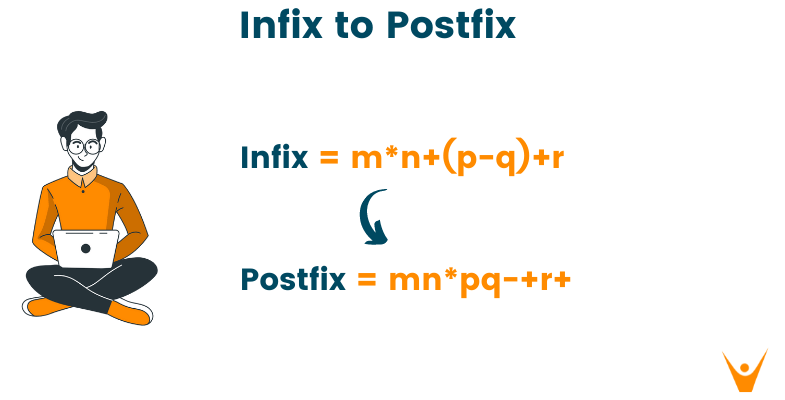In computers, parentheses in an expression can increase the time needed to solve for a solution. To minimize computational complexity, various notations have been devised for representing operators and operands in an expression. So, in this article, let us understand the technique for converting infix to postfix notation along with C++, Java, and Python code implementation.
Before this, we first need to revise a couple of those notations, namely, infix and postfix notation, in detail, along with its example. So, let’s get started!
What is Infix Notation?
When the operator is placed between its operands, it is known as infix notation. The operand is not necessarily a constant or variable; it can also be an expression.
For example: (a + b) * (c + d)
The above expression contains three operators. The operands for the first plus operator are a and b, whereas the operands for the second plus operator are c and d. Evaluating the result of these operations requires applying some set of rules.
At last, after using the addition operator on (a + b) and (c + d), the multiplication operation will be performed to look towards the final answer. Here is the syntax:
<operand> <operator> <operand>
Remember that if there is only one operator in the expression, we do not have to follow any rule set to evaluate the expression. However, if the expression possesses more than one set of operators, you can define the operator's priority according to the below-given table and evaluate the final result.
|
Operators |
Symbols |
|
Parenthesis |
( ), {}, [ ] |
|
Exponents |
^ |
|
Multiplication and Division |
*, / |
|
Addition and Subtraction |
+, - |
What is Postfix Notation?
The expression in which the operator is written after the operands are known as a postfix expression or reverse Polish notation.
For example, the postfix notation of the infix expression (a + b) can be written as ab+.
A postfix expression is an arithmetic expression in which operators are applied from left to right. There is no need for parentheses while working with postfix notation, unlike infix expressions. Moreover, no operator precedence rules or associativity rules are needed, meaning that coders do not need to memorize a special set of rules to help them determine the order in which operations will be performed.
Let us understand the algorithm to define postfix notation using an example:
Algorithm for postfix notation
Let the infix notation of an expression be: a + b * c
Here, we will start scanning the expression from the left side. As the multiplication operator is the first operator appearing while scanning an expression from left to right, the expression will be:
Resultant Expression 1: a + bc*
Again, we scan the expression from left to right, and the next operator encountered will be plus. As a result, the final output of the expression will be:
Resultant Expression 2: abc+*
Therefore, the final algorithmic steps for the postfix expression are:
1) Scanning the expression from left to right 2) If the operand is encountered, push it into the stack 3) If the operator is encountered, then pop the corresponding operand from the stack and perform computation 4) Continue the same process and retain the final value in the stack
How to Convert Infix to Postfix Notation?
Using the stack data structure is the best method for converting an infix expression to a postfix expression. It holds operators until both operands have been processed, and it reverses the order of operators in the postfix expression to match the order of operation.
Here is an algorithm that returns the string in postfix order, left to right. For each token, there are four cases:
- If the current token is an opening parenthesis, push it into the stack.
- If the current token is a closing parenthesis, pop tokens from the stack until a corresponding opening parenthesis is popped. Append each operator to the end of the postfix expression.
- Append the current token to the end of the postfix expression if it is an operand
- If the current token is an operator, append it to the postfix expression with higher precedence than the operator on top of the stack. If it has lower precedence, first pop operators from the stack until we have a higher precedence operator on top, or the stack becomes empty.
- Finally, if you have any remaining operators in the stack, add them to the end of the postfix expression until the stack is empty and return the postfixed expression.
Let us understand the conversion of infix to postfix notation using stack with the help of the below example:
Let the expression be evaluated by m*n+(p-q)+r.
|
Steps |
Current Token |
Operation on Stack |
Stack Representation |
Postfix Expression |
|
1 |
m |
m |
||
|
2 |
* |
Push |
* |
m |
|
3 |
n |
* |
mn |
|
|
4 |
+ |
Push |
+ |
mn* |
|
5 |
( |
Push |
+( |
mn* |
|
6 |
p |
+( |
mn*p |
|
|
7 |
- |
Push |
+(- |
mn*p |
|
8 |
q |
+(- |
mn*pq |
|
|
9 |
) |
Pop and append until the open bracket |
+ |
mn*pq- |
|
10 |
+ |
Push |
+ |
mn*pq-+ |
|
11 |
r |
+ |
mn*pq-+r |
|
|
12 |
end |
Pop until the stack is empty |
mn*pq-+r+ |
Therefore, the final output as postfix notation for the above expression is mn*pq-+r+
Python Code for Infix to Postfix Conversion:
Operators = set(['+', '-', '*', '/', '(', ')', '^']) # collection of Operators Priority = {'+':1, '-':1, '*':2, '/':2, '^':3} # dictionary having priorities of Operators def infixToPostfix(expression): stack = [] # initialization of empty stack output = '' for character in expression: if character not in Operators: # if an operand append in postfix expression output+= character elif character=='(': # else Operators push onto stack stack.append('(') elif character==')': while stack and stack[-1]!= '(': output+=stack.pop() stack.pop() else: while stack and stack[-1]!='(' and Priority[character]<=Priority[stack[-1]]: output+=stack.pop() stack.append(character) while stack: output+=stack.pop() return output expression = input('Enter infix expression ') print('infix notation: ',expression) print('postfix notation: ',infixToPostfix(expression))
Output:
Enter infix expression m*n+(p-q)+r infix notation: m*n+(p-q)+r postfix notation: mn*pq-+r+
Java Code for Infix to Postfix Conversion:
import java.io.*; import java.lang.reflect.Array; import java.util.*; import java.lang.*; public class favtutor{ public static int precedence(char x){ if(x=='^'){ // highest precedence return 2; } else if(x=='*' || x=='/'){ return 1; // second highest precedence } else if(x=='+' || x=='-'){ // lowest precedence return 0; } return -1; // not an operator } public static String InfixToPostfix(String str){ Stack<Character>stk= new Stack<>(); // used for converting infix to postfix String ans=""; // string containing our final answer int n= str.length(); for (int i = 0; i <n ; i++) { char x= str.charAt(i); if(x>='0' && x<='9'){ ans+=x; } else if(x=='('){ // push directly in the stack stk.push('('); } else if(x==')'){ while(!stk.isEmpty() && stk.peek()!='('){ // keep popping till opening bracket is found ans+=stk.pop(); } if(!stk.isEmpty()){ stk.pop(); } } else{ while(!stk.isEmpty() && precedence(stk.peek())>=precedence(x)){ // remove all higher precedence values ans+=stk.pop(); } stk.push(x); } } while(!stk.isEmpty()){ ans+=stk.pop(); } return ans; } }
Output:
m*n+(p-q)+r mn*pq-+r+
C++ Code for Infix to Postfix Conversion:
#include<bits/stdc++.h> using namespace std; // A Function to return precedence of operators int prec(char ch) { if (ch == '^') return 3; else if (ch == '/' || ch == '*') return 2; else if (ch == '+' || ch == '-') return 1; else return -1; } // A Function to convert infix expression to postfix expression string infixToPostfix(string s) { stack<char> st; //For stack operations, we are using C++ built in stack string ans = ""; for (int i = 0; i < s.length(); i++) { char ch = s[i]; // If the current character is an operand, add it to our answer string. if ((ch >= 'a' && ch <= 'z') || (ch >= 'A' && ch <= 'Z') || (ch >= '0' && ch <= '9')) ans += ch; // Append the current character of string in our answer // If the current character of string is an '(', push it to the stack. else if (ch == '(') st.push('('); // If the current character of string is an ')', append the top character of stack in our answer string // and pop that top character from the stack until an '(' is encountered. else if (ch == ')') { while (st.top() != '(') { ans += st.top(); // Append the top character of stack in our answer st.pop(); } st.pop(); } //If an operator is scanned else { while (!st.empty() && prec(s[i]) <= prec(st.top())) { ans += st.top(); st.pop(); } st.push(ch); // Push the current character of string in stack } } // Pop all the remaining elements from the stack while (!st.empty()) { ans += st.top(); st.pop(); } return ans; } int main() { string s; cin >> s; cout << infixToPostfix(s); return 0; }
Output:
m*n+(p-q)+r mn*pq-+r+
Time Complexity
The time complexity of the above solution to convert infix to postfix notation is O(n), where n is the length of infix expression. Similarly, the space complexity for the conversion is O(n) as it requires equal space to execute the solution using the stack data structure.
Infix to Postfix Rules
Let's first go over the guidelines for transforming infix to postfix before talking about the strategy for doing so without using a stack. Following are the guidelines for changing from infix to postfix:
- Output the token if it belongs to an operand.
- If the token is an operator, output operators one at a time from the stack until one with a lower precedence is at the top. Stack the operator that is now active.
- Push the token onto the stack when it is a left parenthesis.
- Pop operators off the stack as well as output them unless a left parenthesis is popped if the token is a right parenthesis. Remove the left parenthesis and throw it away.
The following formula transforms infix to postfix without the use of a stack:
- Create a variable precedence to record the precedence of the most recent operator encountered, along with an empty string postfix.
- Go over every token in the infix expression one by one:
- Add the token to the postfix string if it is an operand.
- Add the token to the postfix string if it is an operator and its precedence is greater than or equal to the order of precedence of the last operator encountered. If not, add the last operator encountered onto the
- postfix string and carry on until you come across an operator with a lower precedence.
- Increase the precedence variable and carry on if the token is a left parenthesis.
- Reduce the precedence variable and go on if the character is a right parenthesis.
- Send the postfix string back.
How to convert infix to postfix without using stack?
Although infix notation provides a popular method for expressing mathematical equations, computing evaluation of infix notation can be challenging due to the need to keep track of operator ordering and associativity.
Converting an expression to postfix notation is one technique to make the evaluation of that expression simpler. Because Postfix notation is linear and does not need to keep up with operator precedence or associativity, it is also referred to as Reverse Polish notation which is simpler to evaluate using a computer.
The operator is positioned between the operands when writing arithmetic expressions in infix notation. Writing arithmetic expressions in postfix notation places the operator after the operands. In the conventional way of transforming infix to postfix, both operands, and operators are kept track of in a stack.
The conversion can be carried out without utilizing a stack, which is advantageous when stack memory is constrained or when using a language that doesn't allow one.
#include <iostream> #include <string> #include <queue> int getPrecedence(char c) { if (c == '*' || c == '/') return 2; else if (c == '+' || c == '-') return 1; else return 0; } std::string infixToPostfix(std::string infix) { std::string postfix; std::queue<char> outputQueue; for (int i = 0; i < infix.length(); i++) { char c = infix[i]; if (isalnum(c)) { postfix += c; } else if (c == '+' || c == '-' || c == '*' || c == '/') { while (!outputQueue.empty() && getPrecedence(outputQueue.front()) >= getPrecedence(c)) { postfix += outputQueue.front(); outputQueue.pop(); } outputQueue.push(c); } else if (c == '(') { outputQueue.push(c); } else if (c == ')') { while (!outputQueue.empty() && outputQueue.front() != '(') { postfix += outputQueue.front(); outputQueue.pop(); } outputQueue.pop(); // Remove the '(' from the output queue } } while (!outputQueue.empty()) { postfix += outputQueue.front(); outputQueue.pop(); } return postfix; } int main() { std::string infix = "a+b*(c+d)-e/f"; std::string postfix = infixToPostfix(infix); std::cout << "Infix: " << infix << std::endl; std::cout << "Postfix: " << postfix << std::endl; return 0; }
Output:
Infix: a+b*(c+d)-e/f Postfix: abcd+*+ef/-
Conclusion
Infix expressions are what we humans use to solve problems normally. However, computers require a stack to solve expressions. Now you know the simplest technique to convert infix to postfix notation using the stack data structure. It is highly recommended to understand this problem thoroughly to make your programming easy and efficient. Happy Learning :)








